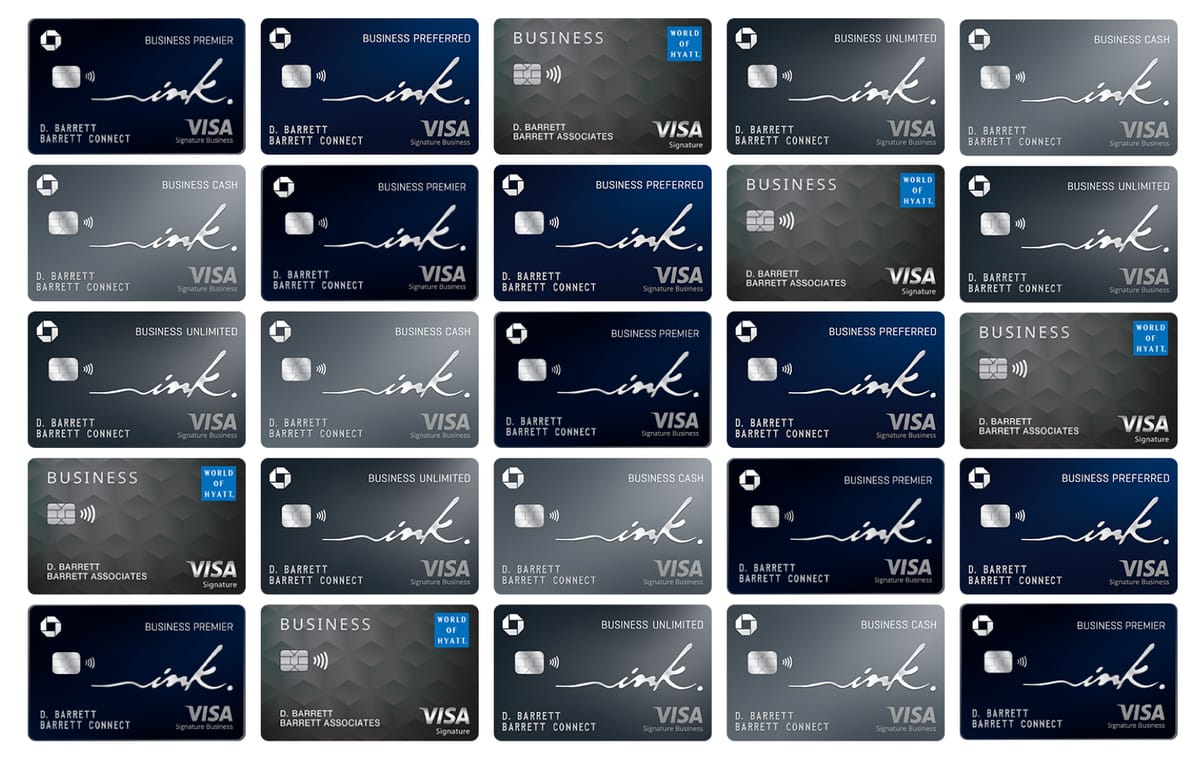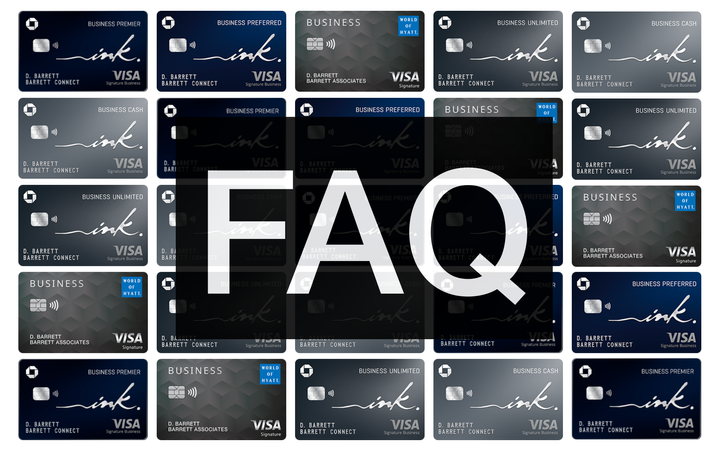Can I Have Multiple Chase Ink Business Cards?
Explore advanced EIN/SSN strategies & name variations in our ultimate guide to securing multiple Chase Ink cards!

If you're delving into this post, chances are you're clutching a Chase Ink Business card and wondering, "Can I boost my points by getting more of these?". The answer is a resounding yes! Not only is it possible to collect all four unique Ink cards, but you can also double—or even triple—dip into the same card type. Picture this: Over the past four years, I've navigated the Chase waters to amass hundreds of thousands of Ultimate Rewards points across more than ten Ink cards. This is enough points for FOUR round-the-world tickets in business class. Intrigued? Stick with me — by the end of this post, you'll be equipped with the savvy to multiply your Chase Ink Business cards and, with them, your travel potential.
Table of Contents
The Benefits of Using Chase Ink Business Cards To Earn Valuable Ultimate Reward Points
Chase Ultimate Reward (UR) points are the unsung heroes for travelers and business owners alike, offering unparalleled versatility and value. They shine particularly bright with transfer options to airlines and hotel partners, like Hyatt, where they often exceed the value of two cents each.


Let's walk through the practical benefits of using Chase Ink Business cards to earn these Ultimate Reward Points:
- Off the Personal Credit Radar: Chase business cards fly under the personal credit report radar, keeping your FICO score unaffected and your credit line healthy.
- Dodging the 5/24 Rule: Using Ink Business cards are a smart way to sidestep Chase's 5/24 rule, allowing you to apply for more Chase business and personal cards to earn even more UR points.
- Straightforward Approval: As long as you navigate within the boundaries of Chase's application rules (link to section), getting approved is typically hassle-free. It's about knowing the route and avoiding the storm.
- 0% APR Promos: In an era of fluctuating interest rates, Chase's 0% APR promotions on the Ink Business Cash and Unlimited cards are a welcome relief.
If you're already building a fleet of Chase Ink Business cards and are curious about expanding your arsenal with Bank of America and American Express, consider signing up for my newsletter. I'll guide you through the steps to getting approved for multiple cards, ensuring your journey in maximizing rewards continues smoothly.
An Overview of Chase Ink Business Cards
The Chase Ink Business series offers four distinct cards, each with its unique set of advantages and considerations. As you'll see in the table below, the ability to transfer points to travel partners stands out as a key feature distinguishing these cards. But that's not all. You'll also want to weigh other factors like international transaction fees, annual fees, and introductory 0% APR offers. In the upcoming section, we'll navigate through these options to help you decide which cards to prioritize for your application strategy.

Recommendation: Get All Four Cards

While the ultimate goal is to acquire all four Ink cards, the sequence in which you apply can significantly impact your rewards strategy. Top of mind should be points transferability. Unless you already hold a Chase Sapphire Reserve, Preferred, or Chase Ink Business Preferred, you're missing out on the opportunity to transfer points to hotel or airline partners. In this case, making the Chase Ink Business Preferred your first catch is a wise move.
I suggest saving the Chase Ink Business Premier for last. Why? Unlike its companions, the Premier doesn't offer point transferability. Instead, it locks you into redeeming points at a fixed rate of one cent each. This limitation dims the allure of its sign-up bonus, especially when you consider that transferable URs often pack more punch, a detail I've dissected in Points Transferability: The Road to More Rewards.
If you'd like to support my journey and yours, consider applying through my referral links below:
- Chase Ink Business Preferred (100K UR from $8K spend)
- Chase Ink Business Cash (90K UR from $6K spend)
- Chase Ink Business Unlimited (90K UR from $6K spend)
- Chase Ink Business Premier ($1K cash back from $10K spend)
How Many Chase Ink Business Cards Can I Have?
The sky's the limit. My journey with Chase Ink Business cards has seen me successfully apply for more than ten cards over the years. What's the takeaway? Not only is it feasible to collect all four distinct types of Chase Ink cards, but it's also entirely possible to get the same card multiple times. However, this path is lined with a few important considerations — the 2/30 and 5/24 rules, the strategy of using an EIN, and the nuances of applying with name variations. We'll dive into these critical details in the following section to ensure you're fully prepared for your applications.
Can I Get More Than One Of The Same Chase Ink Card?

Indeed, you can. My own experience and numerous stories from the community on platforms like Reddit, Doctor Of Credit, and Johnny Africa (one of my favorite travel and personal finance blogs) confirm that securing multiple Chase Ink Business Preferred, Unlimited, and Cash cards over time is possible.
But here's an important note from my personal playbook: I've never kept more than one of the same Chase Ink card for a single business entity at any given time. Why? It's challenging to justify the need for duplicate cards for the same business, and I prefer to avoid the scrutiny that might come from the reconsideration department. My strategy? I keep it fluid, closing one card before reapplying for the same type. This cyclical approach has granted me considerable success with Chase Ink Business card applications.
How To Get Multiple Chase Ink Business Cards
This section details the application rules, how to navigate the Chase Business Ink card application form, and strategies like using your EIN/SSN to unlock the potential of having multiple versions of the same card.
Application Rules: Chase Ink Business
- 2/30 Rule: Chase has a two-card limit within any 30-day period. But here's a pro-tip: business and personal cards are counted separately, giving you a bit more leeway in your application strategy.
- 5/24 Rule: Like a gatekeeper, Chase's 5/24 rule only grants you new cards if you’ve opened fewer than five new personal credit cards across all banks in the last 24 months. Remember, this rule watches over personal cards; business cards slip under the radar.
- Debt-to-Income (DTI) Ratio: While not a carved-in-stone rule, Chase often caps your credit at around 30 to 50% of your total income. If your existing Chase cards are already claiming a large slice of this pie, consider reducing your limits to improve your approval chances.
- Recent Move: If you’ve moved recently, Chase might ask for proof of your new address. My trick to bypass this hurdle is to apply using my previous address and then, once approved, call in to redirect my card to my new address.
Application Guide: Chase Ink Business
For the mid-level churners among us, you probably already have all four Ink cards. If you're embarking on this journey with your first Chase Ink business card, I've got a handy guide to getting approved for Chase Ink Business cards. Now, let's talk about multiplying your success by securing the same card multiple times using two unique strategies.

EIN/SSN Strategy
Before we dive in, let's clarify what an EIN is. An Employer Identification Number, or EIN, is a nine-digit number the IRS assigns to business entities in the U.S. It's like a social security number for your business. Why might a sole proprietor want one? Mainly for privacy. Using an EIN instead of your SSN can shield your personal identity from theft. You may apply for an EIN on the IRS website.

Here's the scoop: By applying for another Chase Ink Business card with your EIN, Chase sees it as a different business, making you eligible for another round of sign-up bonuses (hooray!).
Start with SSN and sole proprietorship for your first series of Ink cards. Then apply for a second series using SSN+EIN as a sole proprietorship. A series refers to all 4 cards in Chase’s Ink portfolio (Ink Preferred, Ink Cash, Ink Unlimited, and Ink Premier). You do not have to apply for the cards sequentially, you can alternate between SSN-only and SSN+EIN applications. For example:
- CIP (SSN)
- CIP (EIN+SSN)
- CIU (SSN)
- CIC (SSN)
- CIU (EIN+SSN)
- And so fourth.
A word of caution for sole proprietors: always align your business name with your full name and keep a copy of your EIN letter from the IRS. Chase sometimes asks for this document for verification, and the names have to match exactly.
But what if have mighty churner ambitions, and you're eyeing a third or fourth bonus? As a sole proprietor with one or several unincorporated businesses, you're typically limited to one EIN (because the business and owner are legally the same). However, if you have multiple incorporated businesses (LLCs or corporations), each can have its own EIN, opening the door to multiple bonuses for the same card.
If you're running an incorporated business under a different name, be prepared to present official documents like Articles of Incorporation or Certificate of Formation, which Chase may also request (more details here).
Name Variation Strategy

While I haven't tried this route personally, there are reports of savvy individuals securing the same Chase Ink Business card multiple times by tweaking their middle name on applications. Think "John Adams Smith," "John A. Smith," and "John Smith." If any readers have had success with this strategy, I’d love to hear from you in the comments below!
Referral-o-mania: Maximizing Chase Ink Business Referrals

Leverage referrals to supercharge your Chase Ink sign-up bonuses. Recently, Chase has upped the ante by offering a whopping 40K UR points for each successful referral. Imagine this: by having your partner in crime (P2) use your referral link, not only do they get the full sign-up bonus, you also bag an additional 40K UR points. It's like hitting two eagles with one stone.
But why stop there?! Keep this points party going by creating a virtuous cycle of referrals. Once your P2 has their card, they can refer you for your next one, and so on. Turn your domestic partnership into a point accumulation powerhouse!
Frequently Asked Questions

Over time, I’ve helped a lot of friends navigate the Chase Ink Business card world. Your curiosity and questions have not gone unnoticed! I've gathered and answered the most common inquiries in a dedicated post. This should clear up any confusion and help you make informed decisions as you expand your portfolio of Chase Ink cards.
Application Process and Eligibility
- Can I apply for another of the same Chase Ink card using only my SSN if I already have one?
- In what order should I apply for the Ink card using SSN or SSN+EIN?
- How often can I apply for these Chase Biz cards and not get denied by Chase?
- Can I get multiple of the same Chase Ink card?
- How does applying for Chase business cards affect my personal credit score?
- What is the Chase 2/30 rule?
- What is the Chase 5/24 rule?
Bonus Eligibility and Referrals
- What is the Chase 24-month bonus eligibility rule for existing cardholders seeking new applications?
- Can I get bonuses on multiple Chase Ink cards?
- How do referral bonuses work with multiple applications?
- Is it possible to self-refer for another card and get a bonus?
Specific Card Questions (CIP, CIU, CIC)
- Can I apply for the same card (like Chase Ink Preferred) again using EIN+SSN?
- How does applying for different Ink cards (CIP, CIU, CIC) work?
Strategy and Timing
- When should I apply for a second card after the first one?
- What strategy should I use for applying with EIN and SSN?
- How many Chase Ink cards can I apply with one EIN?
- Can a sole proprietorship have multiple EINs?
- How does the timing of applications affect approval and bonuses?
- Can I get multiple Chase Ink Cards at once?
Credit Limit and Card Management
- How does the credit limit work with multiple cards?
- Should I cancel my first card when I get a second one?
- Can I shift the credit limit between cards?
- How can I reallocate credit limits across my Chase business cards?
Business Proof and Documentation
- What kind of documentation is needed for business cards?
- Do I need to provide proof of business for EIN applications?
- How do I register for an EIN?
- How does Chase verify the existence of my business?
Conclusion: Mastering the Chase Ink Business Card Game
As we've journeyed through the intricacies of Chase Ink Business cards, you've learned that not only is it possible to acquire all four unique Ink cards, but you can also multiply your rewards by strategically applying for the same card multiple times.
From understanding the pivotal role of transferability in your card selection to navigating the application process with EINs and SSNs, we've got all bases covered thoroughly. The P2 referral strategy (my personal favorite) turns your partnerships into a powerhouse for point accumulation. And while the journey may have its share of complexities, remember, with each new card and every successful referral, you're not just earning points — you're unlocking a ton of free travel opportunities.
If you've tried any of these strategies, hit a snag, or discovered a new path, share your story in the comments below. I’d love to turn this guide into a conversation and continue learning from everyone. For those burning questions, dive into the dedicated FAQ post.



Comments ()